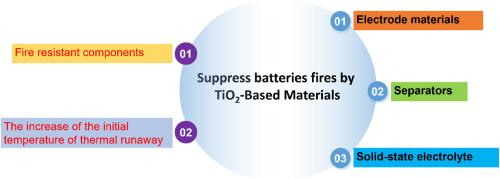Titanium dioxide-based materials for alkali metal-ion batteries: Safety and development
IF 7.9
2区 工程技术
Q1 CHEMISTRY, PHYSICAL
引用次数: 0
Abstract
Recently, lithium-ion batteries (LIBs) have been widely used in fields such as electric vehicles, electric tools and intelligent equipment. However, due to the shortage of lithium resources and high price of lithium, people have raised concerns about the future market of LIBs. Therefore, researchers are also developing other low-cost and high-performance alkali metal-ion batteries. Among them, sodium-ion batteries and potassium-ion batteries will be commercially applied in the near future, due to their rich raw materials, low cost and high energy density. However, alkali metal-ion batteries often face the fire problem during use, which has raised concerns among people. TiO2-based materials are considered as a highly safe, environmentally friendly and non-toxic anode material or additive, which are expected to be used to alleviate the ignition problem of batteries. To facilitate the widespread adoption of TiO2-based materials in the emerging energy storage market, this comprehensive review systematically examines the recent advancements in TiO2-based materials for alkali metal-ion batteries, with a particular focus on their safety-related properties and electrochemical performance. Moreover, this work elucidates the critical scientific challenges and outlines promising research directions for TiO2-based materials in addressing battery safety concerns, thereby providing valuable insights for future developments in this field.

碱金属离子电池用二氧化钛基材料:安全性与发展
近年来,锂离子电池已广泛应用于电动汽车、电动工具和智能装备等领域。然而,由于锂资源的短缺和锂的高价格,人们对锂电池的未来市场提出了担忧。因此,研究人员也在开发其他低成本、高性能的碱金属离子电池。其中,钠离子电池和钾离子电池因原料丰富、成本低、能量密度高,将在不久的将来实现商业化应用。然而,碱金属离子电池在使用过程中经常面临着火问题,这引起了人们的关注。二氧化钛基材料被认为是一种高度安全、环保、无毒的阳极材料或添加剂,有望用于缓解电池的点火问题。为了促进tio2基材料在新兴储能市场的广泛应用,本综述系统地研究了用于碱金属离子电池的tio2基材料的最新进展,特别关注其安全相关特性和电化学性能。此外,这项工作阐明了关键的科学挑战,并概述了二氧化钛基材料在解决电池安全问题方面的有前途的研究方向,从而为该领域的未来发展提供了有价值的见解。
本文章由计算机程序翻译,如有差异,请以英文原文为准。
求助全文
约1分钟内获得全文
求助全文
来源期刊

Journal of Power Sources
工程技术-电化学
CiteScore
16.40
自引率
6.50%
发文量
1249
审稿时长
36 days
期刊介绍:
The Journal of Power Sources is a publication catering to researchers and technologists interested in various aspects of the science, technology, and applications of electrochemical power sources. It covers original research and reviews on primary and secondary batteries, fuel cells, supercapacitors, and photo-electrochemical cells.
Topics considered include the research, development and applications of nanomaterials and novel componentry for these devices. Examples of applications of these electrochemical power sources include:
• Portable electronics
• Electric and Hybrid Electric Vehicles
• Uninterruptible Power Supply (UPS) systems
• Storage of renewable energy
• Satellites and deep space probes
• Boats and ships, drones and aircrafts
• Wearable energy storage systems
 求助内容:
求助内容: 应助结果提醒方式:
应助结果提醒方式:


